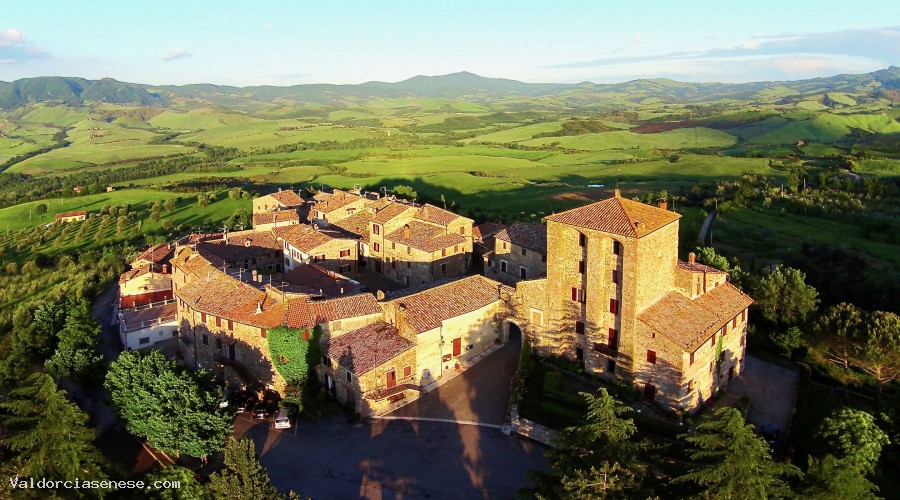Castle
Contignano
RADICOFANI
The origins of Contignano are very ancient and certainly antecedent to the foundation of the Abbey of San Salvatore on Monte Amiata in the year 979 AD. Some scholars believe that a Roman villa, dating back to the II-III century, was the first settlement. This villa was located a little lower than where the castle would have stood, of which the keep, the gates and the walls still exist today. Among the first documentary finds in the history of Contignano there is a sale by Count Ildebrando IV Aldobrandeschi of the lands of Contignano to Foscolo by Pietro Lambardi on 29 September 1028, a gentleman belonging to the small local nobility. Subsequently, Foscolo's son and his wife Maiza donated their properties to the Abbey of San Salvatore, including that of Contignano which remained in the monastery for almost three centuries. The control of the Abbey over the lands of Contignano ended in 1303, since they were entrusted to the Farnese family, through a resolution of the General Council of the Municipality of Siena on 28 May. The Farneses remained lords of Contignano until 6 August 1390 when they sold it to the rich Sienese Cione di Sandro Salimbeni. Later his son Cocco, in open hostility with the Municipality of Siena, was forced to submit its numerous castles and territories, including Contignano, to the Sienese, signing the peace treaty in 1404. Cocco, however, soon resumed fighting against the Sienese but in 1409 the population of Contignano rebelled against the Salimbeni and on 7 December offered the submission of the village and from that moment, Contignano became a free Municipality of the Sienese Republic. On 30 March 1501, despite the agreements, the Sienese sold the lands of Contignano, but not the Castle, to Antonio Giordano da Venafro, a prominent figure of the sixteenth century. In 1515. after a dispute with Borghese Petrucci, Antonio Giordano left Siena and his lands. Subsequently, the ownership of Contignano passed to the Bianchi-Bandinelli family. On 1 January 1778, the free commune was suppressed, on the basis of a provision issued by the Grand Duchy of Tuscany.
The origins of Contignano are very ancient and certainly antecedent to the foundation of the Abbey of San Salvatore on Monte Amiata in the year 979 AD. Some scholars believe that a Roman villa, dating back to the II-III century, was the first settlement. This villa was located a little lower than where the castle would have stood, of which the keep, the gates and the walls still exist today. Among the first documentary finds in the history of Contignano there is a sale by Count Ildebrando IV Aldobrandeschi of the lands of Contignano to Foscolo by Pietro Lambardi on 29 September 1028, a gentleman belonging to the small local nobility. Subsequently, Foscolo's son and his wife Maiza donated their properties to the Abbey of San Salvatore, including that of Contignano which remained in the monastery for almost three centuries. The control of the Abbey over the lands of Contignano ended in 1303, since they were entrusted to the Farnese family, through a resolution of the General Council of the Municipality of Siena on 28 May. The Farneses remained lords of Contignano until 6 August 1390 when they sold it to the rich Sienese Cione di Sandro Salimbeni. Later his son Cocco, in open hostility with the Municipality of Siena, was forced to submit its numerous castles and territories, including Contignano, to the Sienese, signing the peace treaty in 1404. Cocco, however, soon resumed fighting against the Sienese but in 1409 the population of Contignano rebelled against the Salimbeni and on 7 December offered the submission of the village and from that moment, Contignano became a free Municipality of the Sienese Republic. On 30 March 1501, despite the agreements, the Sienese sold the lands of Contignano, but not the Castle, to Antonio Giordano da Venafro, a prominent figure of the sixteenth century. In 1515. after a dispute with Borghese Petrucci, Antonio Giordano left Siena and his lands. Subsequently, the ownership of Contignano passed to the Bianchi-Bandinelli family. On 1 January 1778, the free commune was suppressed, on the basis of a provision issued by the Grand Duchy of Tuscany.